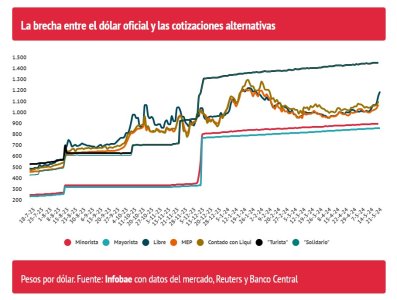All the Answers
Well-known member
The monetary base grew again and, together with the reduction in rates, put pressure on the dollar - Infobae

Source:

La base monetaria volvió a crecer y, junto a la baja de tasas, presiona sobre el dólar
El aumento de la brecha cambiaria puede amenazar el proceso de fuerte desinflación, dependiendo hasta dónde siga creciendo. Se espera mayor absorción de pesos en las próximas jornadas
May 21, 2024
The increase in the exchange gap can threaten the process of strong disinflation, depending on how far it continues to grow. Greater absorption of pesos is expected in the coming days
By Pablo Wende

The already famous “nominal anchor” is a very new aspect that the President has been explaining and that was rarely implemented in Argentina (Illustrative Image Infobae)
Along with the commitment to keep public accounts balanced, one of Javier Milei's main promises is to keep the amount of money circulating in the economy fixed. However, monetary aggregates grew strongly in recent months, which would be behind the pressure of recent days on the different exchange rates.
The now famous “nominal anchor” is a very new aspect that the President has been explaining and that was rarely implemented in Argentina. Basically it consists of keeping the amount of money fixed and thus putting pressure on a rapid reduction in inflation. The prices, in this scheme, should be adapted to the existing weights. Milei once again referred to this policy in his last presentation to businessmen organized by Cicyp.
But the numbers released by the Central Bank show that we are still very far from achieving this “nominal anchor.” The monetary base, for example, has already risen 65% so far this year and has only accompanied the inflation accumulated in the first quarter.
The 10 billion base that the Government received when it took office was far away. In reality, since then that level has been widely surpassed and now stands at practically 16 billion pesos.
The rise in financial dollars in recent days seems to support the hypothesis of those who maintained that there was an exaggerated process of exchange rate delay. The last rate reduction defined by the Central triggered a portfolio change and many chose to switch from pesos to dollars
It is true, however, that the amount of money in our pockets rose much less. The item “banknotes and coins” in the hands of the public grew only 29%. On the other hand, money in the BCRA's current account (basically reserve requirements) grew almost 200%. These resources are immobilized, so they could not generate exchange rate pressure, at least in the short term.
The fiscal surplus of recent months closed one of the taps for monetary issuance: the financing of the Treasury via temporary advances. However, others remain open, such as the remuneration of monetary liabilities (in decline due to the decrease in rates) and the strong purchase of dollars to accumulate reserves, which is done with the expansion of pesos.
In recent weeks there has been a combination of factors that are beginning to take their toll on the dollar. On the one hand, the monetary base expanded strongly, but at the same time the Central Bank accelerated the reduction of interest rates to very negative levels in real terms (the monetary policy rate went from 50% to 40% annually).
The consequence is not only the rise of financial dollars, but also the exchange gap widening again. The cash with settlement is already 25% above the official one, while in the case of the MEP the gap went to 22%.
Yesterday, however, it was notable how the free dollar soared, but financial dollars did not follow as much. Today it will be seen more clearly if the jump of more than 5% was an overreaction. Especially considering that the CCL only rose 3.2% and the price was below the free price (at $1,142), something that is unlikely to be sustained.

The rise in the free dollar in recent days is already 10% and to some extent corrects what some considered a situation of exchange delay. The danger is that if the gap continues to widen, it could impact devaluation expectations and hinder the disinflation process that has been observed in recent months.
Precisely one of the factors that had been playing in favor of lower inflationary pressure was the adjustment of just 2% per month of the official exchange rate. Of course, this policy had the great help of the stability of financial dollars, which led to a gradual fall in the exchange gap.
In its latest statement after the successful review of first quarter goals, the IMF advised moving towards a scheme of “greater exchange rate flexibility” while moving forward with the release of controls. Many interpreted it as a request to accelerate the pace of adjustment of the official dollar, although the Government continues to consider that it is not necessary.

